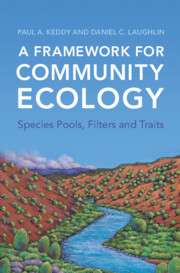Book contents
- A Framework for Community Ecology
- A Framework for Community Ecology
- Copyright page
- Contents
- Preface
- 1 A General Framework for Community Ecology
- 2 Filters
- 3 Species Pools
- 4 Traits
- 5 Trait–Environment Interactions
- 6 Functional Groups
- 7 Predictive Models of Community Assembly
- 8 Prospects and Possibilities
- References
- Index
3 - Species Pools
Published online by Cambridge University Press: 18 November 2021
- A Framework for Community Ecology
- A Framework for Community Ecology
- Copyright page
- Contents
- Preface
- 1 A General Framework for Community Ecology
- 2 Filters
- 3 Species Pools
- 4 Traits
- 5 Trait–Environment Interactions
- 6 Functional Groups
- 7 Predictive Models of Community Assembly
- 8 Prospects and Possibilities
- References
- Index
Summary
Species pools are the result of speciation and extinction, processes that mostly act at long time scales. We make the simplifying assumption that the number of species in the pool is a relatively stable number at the time scales used in community ecology. We describe how standard reference works and classic natural history studies provide data on species pools at a variety of scales. Three types of pools should be distinguished: the regional pool (an unfiltered pool of species which takes into account geographic limits), the habitat-specific pool (a filtered pool which takes into account habitat conditions) and the potential pool (which takes into account species that are adapted to different habitats and potential invasive species). We describe how pools can be constructed by processes including accumulating or downscaling. We discuss the challenges of creating consistent species pools for research and conservation purposes, and conclude that preparing such lists is an important priority in community ecology.
Keywords
- Type
- Chapter
- Information
- A Framework for Community EcologySpecies Pools, Filters and Traits, pp. 76 - 124Publisher: Cambridge University PressPrint publication year: 2021

